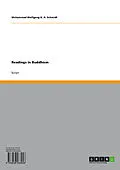A very important initial concept to understanding Buddhism in any of its schools and special adherences to a particular sect, to a Westerner of the Christian faith is certainly the following: "The Buddha (i.e., historical and spiritual founder of the Buddhist movement in India in the 5th pre- Christian century, my insertion, Muh.) based his Teaching on no assumptions, least of all on the two which dominate the Western mind from earliest childhood, an absolute yet personal God, and an immortal soul which must be 'saved', and can only be saved with the assistance of this God....As between the theist and atheist positions, Buddhism is atheist, but it would be more correct to say that it analyzes the complex of conflicting ideas comprised in the term God with the same dispassionate care as it analyzes the so-called soul....The Buddhist teaching on God, in the sense of an ultimate Reality, is neither agnostic, as is sometimes claimed, nor vague, but clear and logical" (Christmas Humphreys, Buddhism: An Introduction and Guide, London 1990 (1951):79). We need these preconceptions and the differences it entails in contrast to a Christian-based worldview in mind when considering the The Three Signs of Being in Buddhism a bit further. In themselves, they constitute a basic Ontology of Life from a clear Buddhist perspective and provide an inventory of existential-qualitative axioms from which Buddhism develops its approach to salvation. In short, these three Signs of Being are: impermanence of all things, suffering, and a non-permanent soul. These are three qualities determining the Being of all Things and are inherent to Life. In earthly life, they are bound to the constant Wheel of Becoming, processes of which are the stages of birth, growth, decay and death. This Wheel is in constant motion, and all things in being are subject to it and three constant Law of Change: Nothing remains the same that it was the moment before. The constant Wheel of Becoming as being in constant motion means reproduction and regeneration of those things subject to decay as they enter the circle of motion again - perhaps in another shape and quality - to go through the process of becoming and disappearing all over again. This idea of rebirths is a concept that Buddhism draws on the teachings of earlier Brahmanism. The quality of impermanence is the first of the Three Signs of Being, those universal qualities determining all forms of lives and existence of things ontologically. [...]
Titel
Readings in Buddhism
EAN
9783638263948
Format
E-Book (pdf)
Hersteller
Genre
Veröffentlichung
01.01.2004
Digitaler Kopierschutz
frei
Dateigrösse
0.41 MB
Anzahl Seiten
34
Untertitel
Englisch
Unerwartete Verzögerung
Ups, ein Fehler ist aufgetreten. Bitte versuchen Sie es später noch einmal.
